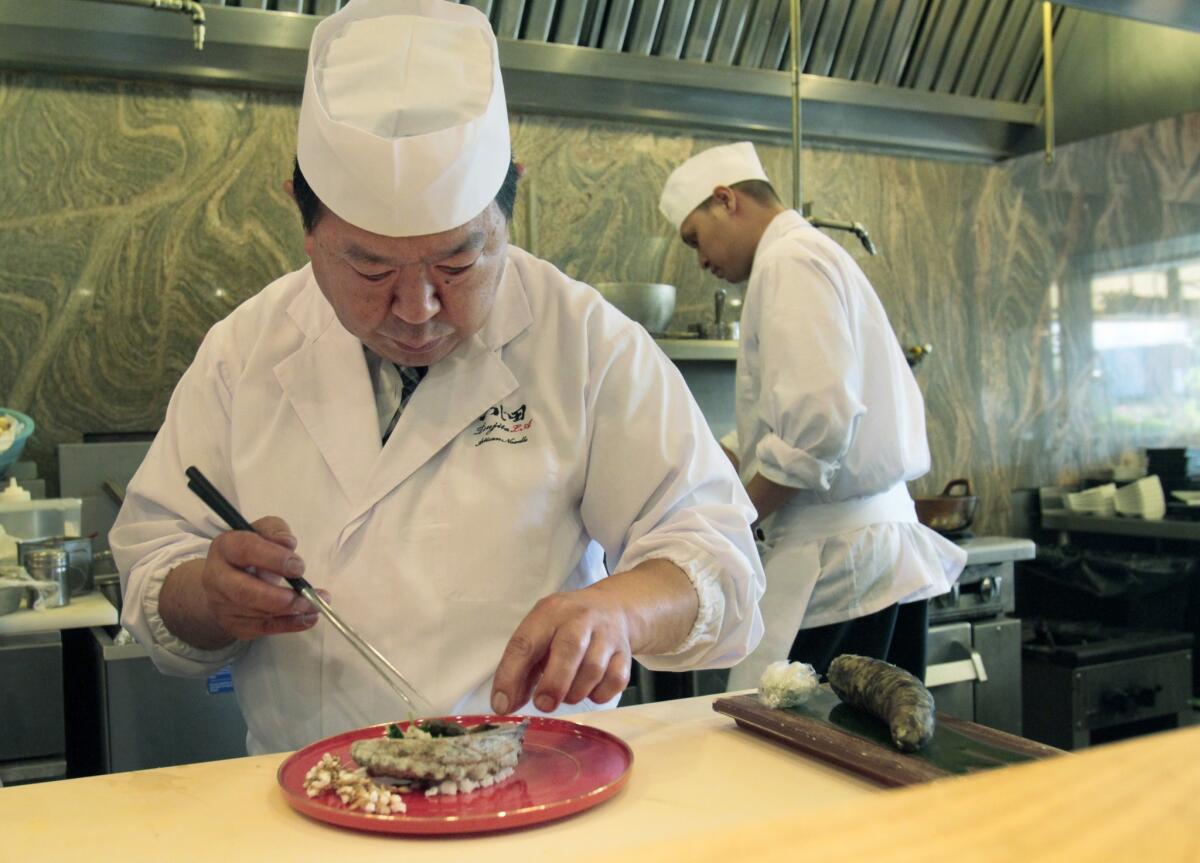Tsujita Sushi offers fish done the old-fashioned way

- Share via
Since the day it opened, Tsujita has attracted mobs to Sawtelle’s Little Osaka neighborhood; on sunny weekends, the wait for a table can last an hour or more. Tsujita, a spinoff of a well-respected Tokyo ramen restaurant, is small and accepts no reservations. It also happens to serve the best ramen in a ramen-crazed part of town, and only at lunch. Across the street, the newer Tsujita Annex serves an ultra-rich, somewhat different kind of ramen for lunch and dinner, soaked in a gravy-thick pork broth and garnished with what seems like double handfuls of chopped back fat. Tsujita Annex also has its lines.
But when you discover the latest addition to the Tsujita empire up the block from the annex, hidden behind a patio festooned with a massive crystal chandelier, you will find that it does not serve noodles at all. L.A.’s Sushi Tsujita is the Tsujita-san’s version of a classic edomae-style sushi bar, intimate and stunningly expensive, specializing in fish prepared using century-old techniques developed to preserve seafood as much as to flavor it: curing with seaweed, salting, pickling.
Chef Shigeru Kato, as well as most of the seafood, is imported from Tokyo. As at Q Sushi downtown, the sushi can sometimes remind you less of fresh fish than of delicate, exquisitely scented Japanese charcuterie. The aim is sushi without compromise. The menu is almost exclusively omakase, chef’s choice, and costs $120, $150 or $180, with the addition of grilled A5 Miyazaki beef. (In my experience, the $120 menu is plenty.)
So to begin, there is a gilded celadon bowl holding steamed Japanese abalone, a bit of steamed spinach and a few dots of yuzu zest.
“Our specialty,” says the waitress.
You discover a single strand of pickled gobo root, whose powerful earthiness slices through the marine richness of the shellfish, and a few wisps of yuba, tofu skin, adding a slippery texture. You encounter the mild funk of the abalone guts. You take a sip of sake. The composition is simple but powerful; a Noguchi sculpture in a bowl.
Next, perhaps, there may be kind of a combination plate, which in early autumn may contain a cross-section of lightly cured roe-bearing ayu, sweetfish; a hunk of baby abalone sharing a skewer with a cube of dense sea urchin omelet; a teaspoonful of slivered squid piled into a hollowed-out yuzu; and a few stalks of rice plunged into hot oil until the grain pops like Rice Krispies.
A tiny teapot turns out to hold the first matsutake mushrooms of the season steeping in broth. You pour a bit of the soup into a saucer and inhale the fragrance: forest floor, wet trees, a sulfurous hint of distant fireworks. You squeeze a drop or two of juice from a sudachi, Japanese lime, into the saucer, and the scent transforms into pure pine. You can eat the mushroom, the scraps of shellfish and eel in the pot when you have finished the broth, but you may not want to. The magic is in the aroma.
And then the sushi comes, perhaps kue, a kind of Japanese grouper seasoned with yuzu and a little salt; the pike mackerel sanma wrapped with a slab of matsutake; or baby yellowtail belly, crosshatched with deep cuts, with a dot of the pepper paste yuzu kosho, or kohada, pickled to the exact point of succulence, with a little soy. This is followed by a cube of fish jelly, garnished with crunchy skin, and a small sashimi platter with Santa Barbara sea urchin and a few cubes of threatened bluefin tuna. (I forgot to specify no bluefin at the beginning of the meal. Don’t make my mistake.)
A small bowl of rice topped with salmon roe and sea urchin. An old-fashioned kind of eel sushi, pressed and cut as if sliced from a log, and the usual toasted-eel sushi. Marinated Japanese scallops with a sliver of pungent black truffle. The clam mirugai cut into what resembles Cthulhu’s tentacles, with more yuzu kosho. You will eat a lot here.
If you are lucky, you will be able to eat sea cucumber roe at Sushi Tsujita, a delicacy rare and expensive even in Japan. The egg sacs are cured, layered and dried into flat triangles the size, shape and alarming orange color of Nacho Cheese Doritos. Toasted, crowned with a few grains of caviar and served warm, the chip is earthy and chewy, slightly briny, with a faint aroma of grilled hazelnuts. It is unlikely you have ever tasted anything quite like it. Sea cucumber ovaries are not large — it may take dozens to make a single chip. It is like taking a bite out of the 19th century.
Sushi Tsujita
Sushi Tsujita offers history you can taste.
Location: 2006 Sawtelle Blvd., West Los Angeles, (310) 231-1177, tsujita-la.com/sushi-tsujita
Prices: Omakase menus, $120, $150 and $180
Details: Open 11:30 a.m. to 2:30 p.m. and 6 p.m. to 10 p.m. Tuesdays to Sundays. Credit cards accepted. Beer, wine and sake. Valet parking in rear, off of La Grange Avenue.
More to Read
Eat your way across L.A.
Get our weekly Tasting Notes newsletter for reviews, news and more.
You may occasionally receive promotional content from the Los Angeles Times.










